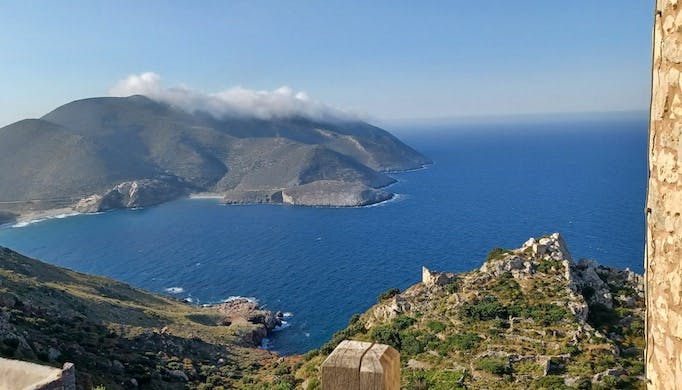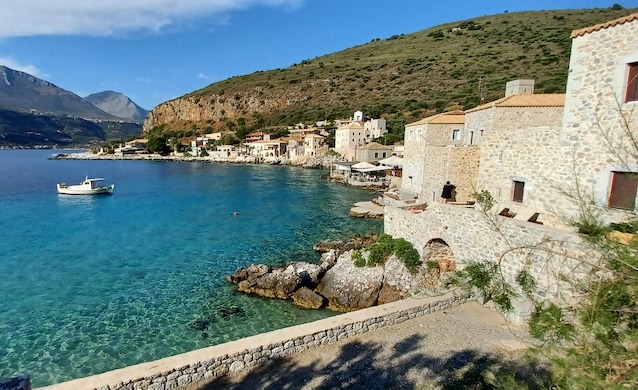A Greek Column: Wending Through Mani, a Hidden Hive of Rebels and Honey
The landscapes oscillate between serene and severe, at one glance windswept and stark and then suddenly sylvan. If Mani inspires all sorts of feelings, warm and fuzzy cannot be counted among them.

A Greek friend responded to my dismay at not being able to find the right words to introduce Mani without doing it some descriptive injustice by instructing that I should say “it’s the opposite of Florida.” When I asked her what she had against Florida, she said: “Nothing, but it’s flat. Mani is mountains — and you did just drive through them.”
That is true, so allow me then to put pedal to metal: On the way to the moody tip of Mani, I spotted two unicorns — well, for sure one — ran over a serpent of indeterminate length, and found myself shepherding about a hundred or so goats to safety in order to make to it my brooding clifftop tower in time for sunset cocktail hour.
Mani feels like the beginning of Europe and also the end of it, and in some respects it is both. Its slender main section forms the middle peninsula of the three that extend south from the larger Peloponnesian peninsula. At Cape Tainaron, the Greek mainland bottoms out; only Spain’s Punta de Tarifa is more southerly in all of Europe.
Mani, though, has a lock on otherworldly: The landscapes oscillate between serene and severe, at one glance windswept and stark and then suddenly sylvan. If Mani inspires all sorts of feelings, warm and fuzzy cannot be counted among them. The place has complex contours and a hard character; even the attempts of one its more touristy villages, Limeni, falls a little flat: too much stone, not enough flowers. It’s floral niceties you want? There’s Holland for that, or maybe Tuscany, but Mani does not do quaint.

The New York Sun/Anthony Grant
Here we are talking rocky moonscapes alternating with green sweeps of olive trees whose leaves sparkle silver in a ceaseless breeze; mists that roll in with San Francisco regularity but then in a flash disappear; the southern Mediterranean sun suddenly illuminating the lonely stone watchtowers with laser-like intensity. In landscapes like these, words may fail but the emotions do fly. Sometimes it feels as if your car will, too. On the way down to Cape Tainaron, the road clings fast above that rare thing: a truly wild expanse of the Mediterranean; you feel less like you are on a back country highway than a runway. You soar.
Historically, Sparta held sway in this remote region, not distant Athens, which is a good three- or four-hour drive away, depending on how much of a hurry you are in. As in Sparta itself, the ruins are few and far between here, which is almost fitting for an area that is embedded in the larger Laconia region — but in austerity there is beauty. There are almost no sights to see and yet every Greek knows this place because it is where the spark of the Greek Revolution crackled into a flame. Centuries of Ottoman Turkish domination of Greece were not easily shaken off, but then the Sublime Porte never had a very firm grasp over this unruly stretch of the Peloponnese.
The Klephts had much to do with that. These were men of the Mani mountains who were essentially highly proficient brigands, sporting competencies that made them anti-Ottoman insurgents almost instantly. They were in revolt against the Turkish intruders even before the Greek revolution took hold in 1821. If the linguistic legacy they bequeathed — we owe the word kleptocracy to them — is less than glorious, their fierceness is what helped forge the character of the modern Greek nation.
Geography, too, drilled an independent streak into the Mani character. Up until the 1970s there were still some Mani villages that could only be reached from the sea.
The big town in the heart of Mani is Areopoli, which is named for the ancient Greek god of war, Ares. Most of its buildings are fashioned out of stone burnished blond by the sun, making for an aesthetic that stands in complete contrast to what the traveler will find in many Greek islands of, say, the Cycladic archipelago. You get a sense that the mostly low, square houses here, like the squat Byzantine watchtowers that dominate the Mani hill towns for miles around, were meant to withstand more than just the weather.
Slightly north from Areopoli, past its little port of Limeni, there is the ruined fortress of Kelefa, spectacularly situated on a peak beyond which stretches the Mediterranean Sea. The Ottomans installed it there in 1679 as a means to exert control over lower Mani, but in this they failed. The Venetians managed to hang on to it for a spell, though.

The New York Sun/Anthony Grant
My mission in Mani was less martial in nature, though fighting the enemy of time does require some deft maneuvering when roads are unknown, and sometimes jammed with goats. A few minutes outside of Porto Kagio, a village on Cape Tainaron, I had to hit the brakes when first one, then three, then a whole herd of impressively blasé goats streamed into the road. I rolled up my windows quickly lest some wayward horns intrude. There were a couple shepherd dogs about, equally indifferent to the traffic intrusion. Then a Greek driver coming from the opposite direction gave his horn a workout and in a cacophony of goat bells and honks the hoofed interlopers dispersed.
Well, maybe I was the interloper. Now liberated, though, I proceeded to my provisional Maniot perch, an ancient watchtower converted by the architect-hotelier Kostas Zouvelos into a seaside aerie the likes of which, jaded traveler though I am, I had not seen before. Called Tainaron Blue, it has just three rooms in the tower and a couple outside it. Mine was up top, and the only way to reach it was by a short but very steep staircase that is essentially a ladder. It is above a small kitchen that turns out delicious food that draws almost exclusively on local ingredients.
The Tainaron Blue breakfast is as much theater as it is repast, accompanied as it is by a ravishing sea view and pure air that both whisper, “Slow down.” Think fresh bread served with homemade jams and delicate flower honey from Mani, which is some of the best you can taste in Greece. Perfectly round, thin omelets and lightly spiced Mani artisanal sausage, hortopitakia (mini aromatic pies filled with greens), chilled pomegranate juice — and you don’t even have to order any of this: It just arrives.

For dinner I tried a Mediterranean “tataki” made with tender Mani beef, which followed a generously portioned Greek salad that delighted in its tanginess, accented with delectable olive oil, plump capers, local farm cheese, and a rarity that for this diner constitutes a plated luxury: tomatoes that have already been peeled.
There was local Mani wine, too, but I swear I wasn’t drinking any when I spotted that unicorn along the road, somewhere between the semi-abandoned, certifiably surreal village of Vathi and my watchtower. Okay, so maybe I just wish I could call that little castle my own, and perhaps the creature was simply a white horse, or a particularly lissome ram.
There is something Irish and mystical about this place. Sipping a tall iced espresso after breakfast, I watched clouds roll in from this forgotten corner of the Mediterranean, amass over the peak opposite the wave-lashed indigo bay far below and just as quickly disappear, like a purifying fog. Ethereal: That’s what this place is. It’s a word of Greek origin, so I guess I am doomed to be derivative. Yet in lonely Mani you come closer to understanding what the ancient ones really meant, and that is less fantasy than a kind of thrill.

